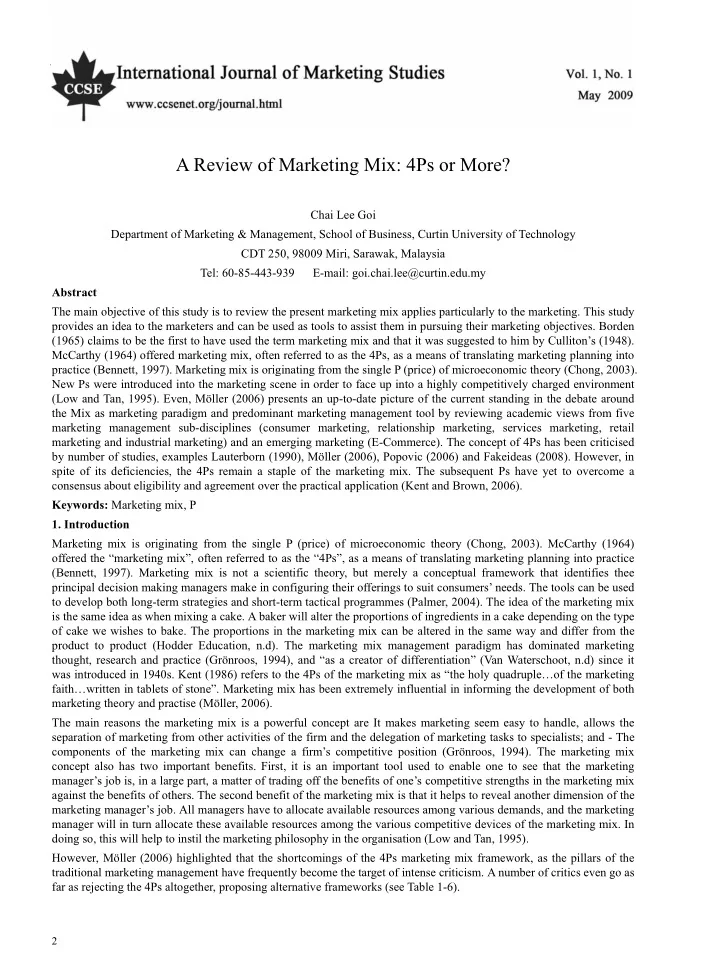

Vol. 1, No. 1 International Journal of Marketing Studies A Review of Marketing Mix: 4Ps or More? Chai Lee Goi Department of Marketing & Management, School of Business, Curtin University of Technology CDT 250, 98009 Miri, Sarawak, Malaysia Tel: 60-85-443-939 E-mail: goi.chai.lee@curtin.edu.my Abstract The main objective of this study is to review the present marketing mix applies particularly to the marketing. This study provides an idea to the marketers and can be used as tools to assist them in pursuing their marketing objectives. Borden (1965) claims to be the first to have used the term marketing mix and that it was suggested to him by Culliton’s (1948). McCarthy (1964) offered marketing mix, often referred to as the 4Ps, as a means of translating marketing planning into practice (Bennett, 1997). Marketing mix is originating from the single P (price) of microeconomic theory (Chong, 2003). New Ps were introduced into the marketing scene in order to face up into a highly competitively charged environment (Low and Tan, 1995). Even, Möller (2006) presents an up-to-date picture of the current standing in the debate around the Mix as marketing paradigm and predominant marketing management tool by reviewing academic views from five marketing management sub-disciplines (consumer marketing, relationship marketing, services marketing, retail marketing and industrial marketing) and an emerging marketing (E-Commerce). The concept of 4Ps has been criticised by number of studies, examples Lauterborn (1990), Möller (2006), Popovic (2006) and Fakeideas (2008). However, in spite of its deficiencies, the 4Ps remain a staple of the marketing mix. The subsequent Ps have yet to overcome a consensus about eligibility and agreement over the practical application (Kent and Brown, 2006). Keywords: Marketing mix, P 1. Introduction Marketing mix is originating from the single P (price) of microeconomic theory (Chong, 2003). McCarthy (1964) offered the “marketing mix”, often referred to as the “4Ps”, as a means of translating marketing planning into practice (Bennett, 1997). Marketing mix is not a scientific theory, but merely a conceptual framework that identifies thee principal decision making managers make in configuring their offerings to suit consumers’ needs. The tools can be used to develop both long-term strategies and short-term tactical programmes (Palmer, 2004). The idea of the marketing mix is the same idea as when mixing a cake. A baker will alter the proportions of ingredients in a cake depending on the type of cake we wishes to bake. The proportions in the marketing mix can be altered in the same way and differ from the product to product (Hodder Education, n.d). The marketing mix management paradigm has dominated marketing thought, research and practice (Grönroos, 1994), and “as a creator of differentiation” (Van Waterschoot, n.d) since it was introduced in 1940s. Kent (1986) refers to the 4Ps of the marketing mix as “the holy quadruple…of the marketing faith…written in tablets of stone”. Marketing mix has been extremely influential in informing the development of both marketing theory and practise (Möller, 2006). The main reasons the marketing mix is a powerful concept are It makes marketing seem easy to handle, allows the separation of marketing from other activities of the firm and the delegation of marketing tasks to specialists; and - The components of the marketing mix can change a firm’s competitive position (Grönroos, 1994). The marketing mix concept also has two important benefits. First, it is an important tool used to enable one to see that the marketing manager’s job is, in a large part, a matter of trading off the benefits of one’s competitive strengths in the marketing mix against the benefits of others. The second benefit of the marketing mix is that it helps to reveal another dimension of the marketing manager’s job. All managers have to allocate available resources among various demands, and the marketing manager will in turn allocate these available resources among the various competitive devices of the marketing mix. In doing so, this will help to instil the marketing philosophy in the organisation (Low and Tan, 1995). However, Möller (2006) highlighted that the shortcomings of the 4Ps marketing mix framework, as the pillars of the traditional marketing management have frequently become the target of intense criticism. A number of critics even go as far as rejecting the 4Ps altogether, proposing alternative frameworks (see Table 1-6). 2
Recommend
More recommend